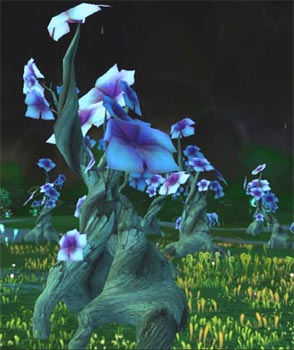From EncyclopAtys
Rotoa Bravichi is an only known true tree of the Prime Roots. First desribed by Atisian botanist Lenardi Bravichi it was frequently used by Sculptor of life as a decoration of Matisian aprtments.
An Excerpt from the "Incomplete Atysian botanical atlas" by Komi the Nameless
Rotao is a permanently flowering tree with a twisted trunk which might seem an intertwined bunch of smaller individual trees . The study of the roots confirms this assumption, however these are simply large branches growing upwards and intermingled with each other. The smell of the large and beautiful pinkishwhite flower is very delicate, and when it is fertilized, the seed ripens at the center of the flower. The rotao does not have leaves, it draws the sap from deep within the soil of Atys. Some researchers claim that the large Rotao flowers are capable of capturing sounds and transforming it into a form of energy used to nourish the plant. It should be noted that this plant, indigenous to Prime roots has been aat a certain point in time transported to Avalae by a famous matisian botanist Lenardi Bravichi responsible for planting forests and creating certain parts of landscape from scratch in Fleeting garden.
The fact that until recently this plant has never been seen outside Prime roots (with the exception of Avalae) prooves that it does not use travelling roots as a means of reproduction. Most likely (given the size and aboundance of the flowers) it uses the indigenous airborne fauna of the prime roots for pollenation, but then later the seeds ripen within the trunk itself, slowly travelling to the roots, where they enter the bulbous tubers, grown by the tree precisely for that reason. Allthough rather uncommon, such form of reproduction is known to Atysian botanists. This also explains why noone has ever seen the Rotoa fruit. The undrground Rotoa tubers are the favourite food of burrowing molluscs, aboundant in the prime roots but not seen anywhere else on Atys. They devour the tubours and spread the minuscle Rotoa seeds, providing them with additional nourishment by generously apportioning the future Rotoa with their excrement.




